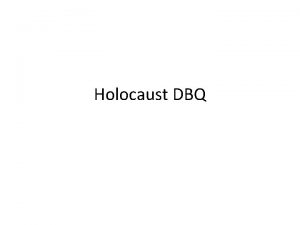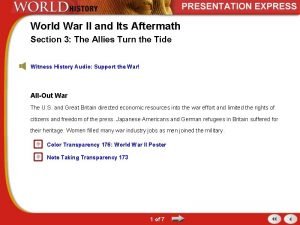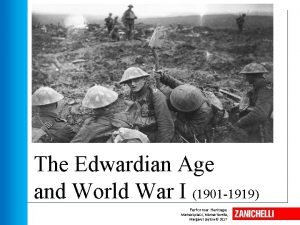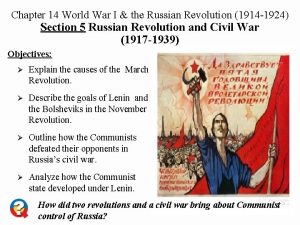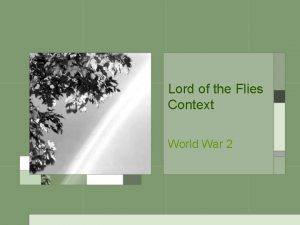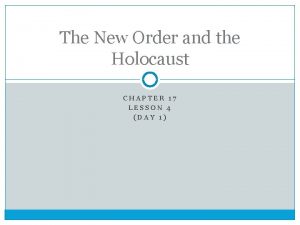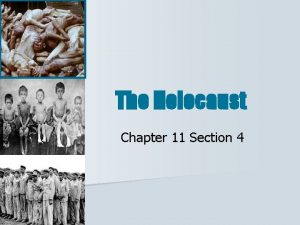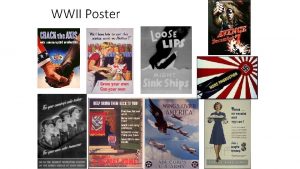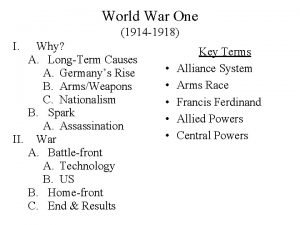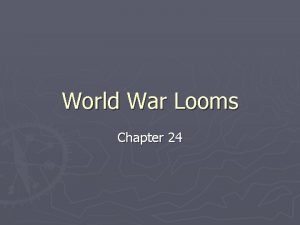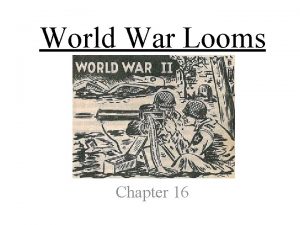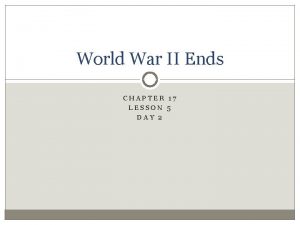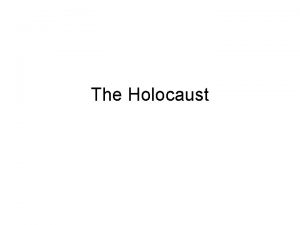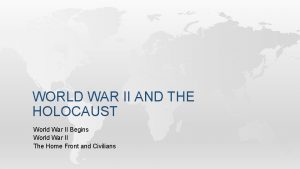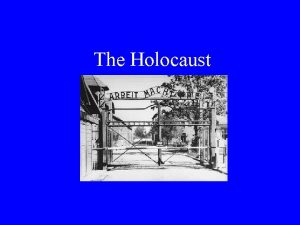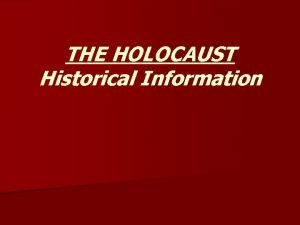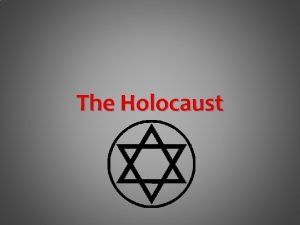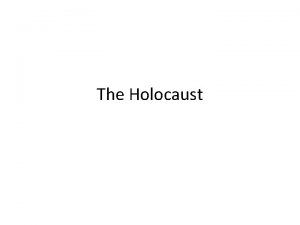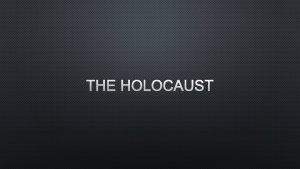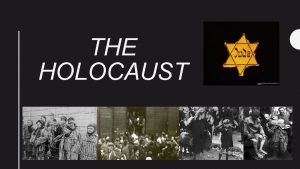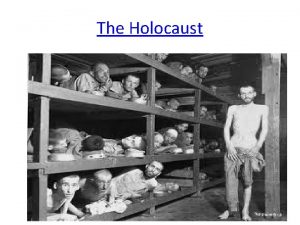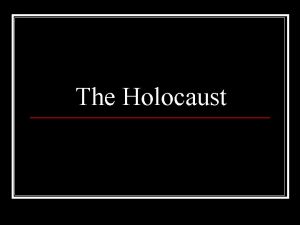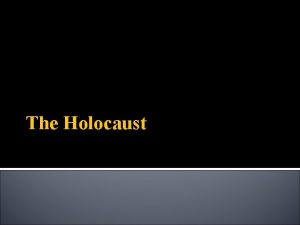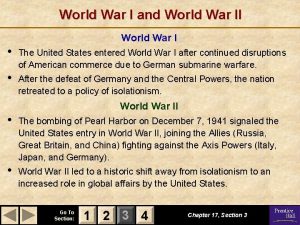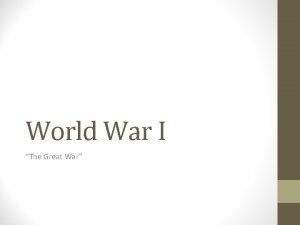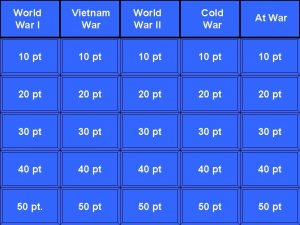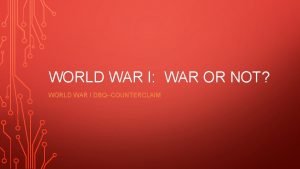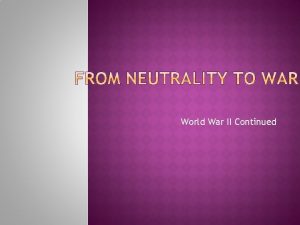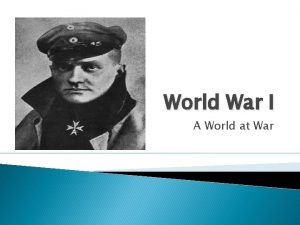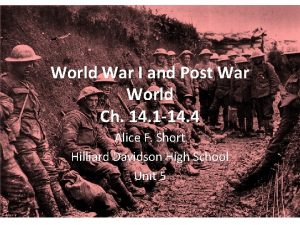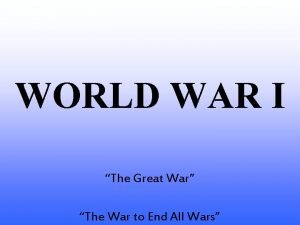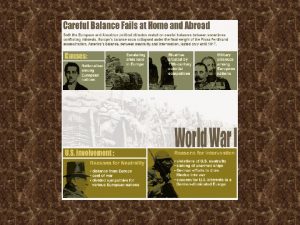World War II and the Holocaust Holocaust The


























- Slides: 26

World War II and the Holocaust

Holocaust • “The state-sponsored, systematic persecution and annihilation of European Jewry by Nazi Germany and its collaborators between 1933 and 1945. – United States Holocaust Museum

The Road to War • Germany’s defeat in WWI brought about the formation of a new government: The Weimar Republic • Treaty of Versailles-ended WWI – Germany had to acknowledge responsibility for the war – Forced to make reparations to all of the countries they “damaged” in the war – Total bill was equivalent to nearly $70 billion – German army was dramatically limited in size

The Road to War • Many Germans protested not only the loss of the war, but the restrictions and reparations placed on them • Extremists blamed Jews for Germany’s defeat and blamed the German Foreign Minister, a Jewish man, for reaching a settlement • Ultimately, many aspects of the treaty were violated or ignored, with little enforcement from the rest of Europe

The Road to War • Despite the flouting of the treaty, Germany’s post-war economy collapsed • The German mark’s value plummeted, causing hyperinflation • Nearly 6 million Germans were unemployed

Rise of the Nazi Party • Weakened economy and ineffective Weimar Republic led to rise of Adolf Hitler and the National Socialist German Worker’s Party • Hitler voted chancellor – Promised to restore law & order – Promised to revive economy – Restore German greatness & save country from Communism

Totalitarianism • The total control of a country and its culture by the government • Subjugates individual rights • Demonstrates policy of aggression • Domination by paranoia and fear

Anti-Semitism • Prior to 1933, Jews were living in every country in Europe (approx. 9 million total) • Poland the Soviet Union had the largest Jewish populations • The long history of Anti-Semitism and persecution of Jews dates back over 2, 000 years • Germans used propaganda to promote their anti-semitic ideas. This included children’s books used in schools

The Nuremberg Laws • During the first few years of Nazi rule, laws were passed restricting the rights of Jews • Nuremberg Laws of 1935 – Stripped Jews of German citizenship – Prohibited them from marrying or having sexual relations with persons of “German or related blood. ” – Jews were deprived of most political rights and were excluded from economic and educational spheres – Forced to carry identity cards with red “J” stamp, to allow for easy identification by police

Persecution • The Nazi plan for dealing with the “Jewish problem” evolved in three steps: – 1. Expulsion-Get them out of Germany – 2. Containment-Put them together in one placenamely, the ghettos – 3. “Final Solution”-Annihilation Other groups targeted included Gypsies, Homosexual men, Jehovah’s Witnesses, Physically and mentally handicapped Germans (Euthanasia Program), Poles, and Political dissidents

Kristallnacht • “Night of the Broken Glass” • November 9 -10, 1938 • Germans attacked synagogues and Jewish homes and businesses • 91 murdered, 30, 000 deported and sent to concentration camps • By 1939, half of Germany’s 500, 000 Jews had emigrated to escape Nazi persecution

Invasion and War • 1939 -Germany invaded Poland, beginning World War II – Pop. 3 million Polish Jews • 1941 -Germany invaded Russia – Pop. 5 million Russian Jews

Einsatzgruppen • Specially trained SS units-essentially “mobile killing squads” • Sent by Heinrich Himmler into German occupied territory to shoot Jews, Gypsies, and Russian political dissidents • Estimated to have killed 1. 3 million Jews between 1941 and 1945 • Victims were taken to deserted areas where they were forced to dig their own graves and shot

Final Solution • January 1942 -Himmler called conference to discuss tactics against Jews and other “threats to the race” • Existing methods were deemed inefficient-bullets were needed for war effort • Jews would be rounded up and moved to ghettos, or used as cheap labor • Other Jews sent to “resettlement areas” where they would go through “selection” – Young and fit– “destruction through work” – Women, children, old, and sick– “special treatment”

Final Solution • Ghettos were established across occupied Europe, usually in areas with a large Jewish population • Life was very difficult-lack of food, overcrowding, limited heating and sanitation • Conditions designed so many would die and others would be willing to leave in the hope of better conditions • How were people determined to be Jewish? – If one parent was Jewish – If three or four grandparents were Jewish (if only one, they could be classified as German)

Concentration Camps • Three types of camps: transit, labor, extermination • First camp (Dachau) opened in 1933 for political dissidents and prisoners • There were six death camps, all located in Poland: Auschwitz-Birkenau (also a labor camp), Treblinka, Chelmno, Sobibor, Majdanek, and Belzec – Treblinka had a staff of 80 guards, 20 -30 SS – 850, 000 killed in 14 months

Great Deception • Deception – Jews told they were going to “resettlement areas” in the East – Told to bring tools, pots and pans, etc. – New arrivals at death camps given postcards to send to friends • Starvation – Jews in Warsaw ghetto fed only 1000 calories a day • Terror – SS publicly shot people for smuggling food/supplies or engaging in any act of resistance

Gas Chambers • Designed for efficient mass execution • Those “selected” would be given soap and sent to gas chambers sometimes disguised as showers • Nazis would force large groups of prisoners into small cement rooms and drop canisters of Zyklon B or carbon monoxide through holes in the roof • Nazis would try to pack as many as 2000 into a gas chamber like the one pictured

Gas Chambers • Jews selected as sonderkommando were ordered to remove gold fillings and hair of victims and feed bodies into crematorium. • About 25, 000 pairs of shoes-one day’s collection at the peak of gassing

Resistance Movements • Despite extremely high risk, some individuals and groups attempted to resist Nazism and Nazi policies – – – The “White Rose” movement The Warsaw Ghetto uprising Sobibor escape Sonderkommando blowing up Crematorium IV at Birkenau Jewish partisans who escaped to fight in the forests • Still, less than 1% of non-Jewish European population helped in rescue operation • Denmark and Bulgaria demonstrated most successful national resistance movements against attempts to deport their Jewish citizens

Liberation • July 23, 1944—Soviet soldiers liberated first camp prisoners at Majdanek • British, Canadian, American, and French troops also liberated camp prisoners • Troops were shocked at what they saw – Prisoners emaciated to the point of being skeletal – Many camps had dead bodies stacked in huge piles – Many prisoners died even after liberation

Aftermath • The Nazis killed at least 6 million Jews – – 2 -3 million Soviet P. O. W. ’s About 1. 9 million non-Jewish Poles 220, 000 -500, 000 Roma Gypsies 200, 000 physically/mentally handicapped • Camp prisoners became “displaced persons” – Many stayed in camps in Germany run by the Allies – Jewish DPs pushed for the founding of a Jewish state in British-controlled Palestine – Jewish refugees allowed to enter U. S. without normal immigration restrictions

Nuremberg Trials • Brought to justice some responsible for the atrocities of the war • 22 Nazi war criminals tried by the Allies in the International Military Tribunal • 12 prominent Nazis were sentenced to death – Most claimed they were only following orders; this was judged to be an insufficient defense – Unfortunately, many perpetrators have never been tried or punished

Maus

Art Spiegelman • Celebrated cartoonist • Work published in numerous journals and other media (The New York Times, The Village Voice) • Drawings have been exhibited in museums around the world • He lives in NYC with wife and daughter • He has won numerous awards for his work, including the 1992 Pulitzer Prize for Maus

Maus • Maus: A Survivor’s Tale is a graphic memoir • It recounts Spiegelman’s father’s struggle to survive the Holocaust as a Polish Jew • It draws largely on his father’s recollections of events he personally experienced • It also follows the author’s troubled relationship with his father and the way the effects of war continue to reverberate through generations of a family
 Dbq holocaust
Dbq holocaust Chapter 16 lesson 2 challenges to slavery
Chapter 16 lesson 2 challenges to slavery James madison war at home
James madison war at home Description
Description Welcome 1 unit 10 lesson 1
Welcome 1 unit 10 lesson 1 Comparing reconstruction plans venn diagram
Comparing reconstruction plans venn diagram Josette dugas war of 1812
Josette dugas war of 1812 Ich war du warst
Ich war du warst Study jams force and motion
Study jams force and motion Why was the civil war the first modern war
Why was the civil war the first modern war Already simple past
Already simple past Cold war proxy wars
Cold war proxy wars Chapter 30 the war to end war
Chapter 30 the war to end war Chapter 30 the war to end war
Chapter 30 the war to end war World war 2 and its aftermath section 3 quiz
World war 2 and its aftermath section 3 quiz Chapter 27 world war 1 and the russian revolution
Chapter 27 world war 1 and the russian revolution Edwardian age zanichelli
Edwardian age zanichelli Kzbho6asboc -site:youtube.com
Kzbho6asboc -site:youtube.com Lord of the flies and world war 2
Lord of the flies and world war 2 The new order in europe lesson 4
The new order in europe lesson 4 Upstanders and bystanders during the holocaust
Upstanders and bystanders during the holocaust How did the holocaust develop and what were its results
How did the holocaust develop and what were its results Propaganda posters bandwagon
Propaganda posters bandwagon Results of the world war 1
Results of the world war 1 Chapter 24 building vocabulary world war looms
Chapter 24 building vocabulary world war looms Chapter 16 world war looms vocabulary
Chapter 16 world war looms vocabulary Lesson 5 world war ii ends
Lesson 5 world war ii ends
